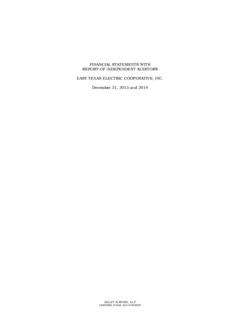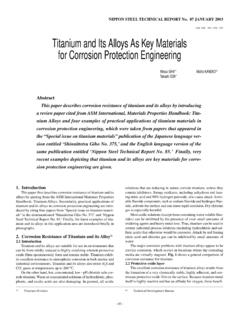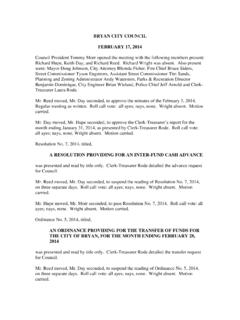Transcription of World report on - UNICEF
1 World report on child injury prevention World report on child injury prevention Edited by Margie Peden, Kayode Oyegbite, Joan Ozanne-Smith, Adnan A Hyder, Christine Branche, AKM Fazlur Rahman, Frederick Rivara and Kidist Bartolomeos WHO Library Cataloguing-in-Publication Data: World report on child injury prevention / edited by Margie Peden [et al]. and injures - prevention and control. prevention . welfare. Health Organization. ISBN 978 92 4 156357 4 (NLM classification: WA 250). World Health Organization 2008. All rights reserved. Publications of the World Health Organization can be obtained from WHO Press, World Health Organization, 20 Avenue Appia, 1211 Geneva 27, Switzerland (tel.: +41 22 791 3264; fax: +41 22 791 4857; e-mail: Requests for permission to reproduce or translate WHO publications whether for sale or for noncommercial distribution should be addressed to WHO Press, at the above address (fax: +41 22 791 4806; e-mail: The designations employed and the presentation of the material in this publication do not imply the expression of any opinion whatsoever on the part of the World Health Organization or UNICEF concerning the legal status of any country, territory, city or area or of its authorities, or concerning the delimitation of its frontiers or boundaries.))
2 Dotted lines on maps represent approximate border lines for which there may not yet be full agreement. The mention of specific companies or of certain manufacturers' products does not imply that they are endorsed or recommended by the World Health Organization or UNICEF in preference to others of a similar nature that are not mentioned. Errors and omissions excepted, the names of proprietary products are distinguished by initial capital letters. All reasonable precautions have been taken by the World Health Organization or UNICEF to verify the information contained in this publication. However, the published material is being distributed without warranty of any kind, either expressed or implied. The responsibility for the interpretation and use of the material lies with the reader. In no event shall the World Health Organization or UNICEF be liable for damages arising from its use.
3 Cover design by INIS. Graphics by minimum graphics and L'IV Com S rl. Printed in Switzerland. CONTENTS. Contents Foreword vii Contributors ix Acknowledgements xiii Introduction xv Chapter 1. child injuries in context 1. Background 1. What is an injury ? 1. Who is a child ? 1. Why is child injury important? 1. How does child injury relate to other child health concerns? 2. Children's injuries and the changing World 3. The characteristics of child injury 5. The child - injury pyramid 5. Fatal child injuries 5. Non-fatal child injuries 7. child injury and age 8. child injury and gender 9. child injury and socioeconomic factors 9. The preventability of child injury 12. The principles of injury prevention 12. Learning from places with good safety records 16. Which approaches work? 16. Universal and targeted interventions 18. Cost and cost-effectiveness 20.
4 Overcoming the obstacles 20. Conclusion 22. References 22. Chapter 2. Road traffic injuries 31. Introduction 31. Epidemiology of road traffic injuries 31. Mortality 31. Morbidity 33. Types of road user 34. Economic impact of road traffic injuries 36. Limitations of data 36. Risk factors 36. child -related factors 36. Vehicle-related factors 41. Environmental factors 41. Lack of prompt treatment 41. Interventions 42. Engineering measures 42. Vehicle design 43. Safety equipment 43. World report ON child injury prevention III. Legislation and standards 46. Developing education and skills 47. Emergency and trauma care 48. Potentially harmful interventions 49. Evaluating interventions 49. Conclusion and recommendations 49. Recommendations 49. References 51. Chapter 3. Drowning 59. Introduction 59. Epidemiology of drowning 59. Mortality 59. Morbidity 62.
5 Economic impact of drowning 62. Limitations of data 63. Risk factors 63. child -related factors 63. Agent factors 65. Environmental factors 66. Access to treatment and rehabilitation 66. Interventions 66. Engineering measures 67. Environmental measures 67. Legislation and standards 68. Developing education and skills 69. Managing drowning 71. Adapting interventions 72. Further research on interventions 72. Conclusions and recommendations 72. Recommendations 72. References 73. Chapter 4. Burns 79. Introduction 79. Epidemiology of burns 80. Mortality 80. Morbidity 81. Limitations of data 84. Risk factors 84. child -related factors 85. Agent factors 86. Environmental factors 86. Protective factors 86. Interventions 87. Engineering measures 87. Environmental measures 88. Laws and regulations 88. Educational approaches 89. Combined strategies 89. Managing burns 90.
6 Adapting interventions 93. Evaluating interventions 93. IV World report ON child injury prevention . Conclusions and recommendations 93. Recommendations 93. References 94. Chapter 5. Falls 101. Introduction 101. Epidemiology of falls 101. Mortality 102. Morbidity 102. Cost of fall-related injury 105. Limitations of data 106. Risk factors 106. child -related factors 106. Agent factors 107. Environmental factors 109. Lack of treatment and rehabilitation 110. Interventions 110. Engineering measures 110. Environmental measures 110. Laws and regulations 111. Educational approaches 111. Combining strategies 112. Adapting interventions 113. Involving a range of sectors 114. Conclusions and recommendations 114. Recommendations 114. References 115. Chapter 6. Poisonings 123. Introduction 123. Epidemiology of poisoning 123. Mortality 123. Morbidity 125.
7 Types of poison 125. Cost of poisoning-related injury 127. Limitations of data 127. Risk factors 129. child -related factors 129. Agent factors 130. Environmental factors 131. Lack of prompt treatment 132. Interventions 132. Engineering measures 132. Environmental measures 134. Laws and regulations 134. Educational approaches 135. Managing poisoning 135. Involving a range of sectors 137. Evaluating interventions 137. Conclusions and recommendations 137. Recommendations 138. References 138. World report ON child injury prevention V. Chapter 7. Conclusions and recommendations 145. Introduction 145. Main messages from the report 145. child injuries are a major public health issue 145. Injuries directly affect child survival 145. Children are more susceptible to injuries 145. child injuries can be prevented 146. The cost of doing nothing is unacceptable 147.
8 Few countries have good data on child injuries 148. Research on child injuries is too limited 148. There are too few practitioners in child injury prevention 149. child injuries is the responsibility of many sectors 150. child injury prevention is underfunded 150. Awareness needs to be created and maintained 150. Recommended actions 151. Translating recommendations into reality 153. Conclusion 154. References 155. Statistical annex 157. Index 203. VI World report ON child injury prevention . FOREWORD. Foreword Every day around the World the lives of more than 2000 families are torn apart by the loss of a child to an unintentional injury or so-called accident that could have been prevented. The grief that these families suffer mothers, fathers, siblings, grandparents and friends is immeasurable and often impacts entire communities. Such tragedy can change lives irrevocably.
9 Once children reach the age of five years, unintentional injuries are the biggest threat to their survival. Unintentional injuries are also a major cause of disabilities, which can have a long-lasting impact on all facets of children's lives: relationships, learning and play. Among those children who live in poverty, the burden of injury is highest, as these children are less likely to benefit from the protective measures others may receive. child injuries have been neglected for many years, and are largely absent from child survival initiatives presently on the global agenda. Through this World report on child injury prevention , the World Health Organization, the United Nations Children's Fund and many partners have set out to elevate child injury to a priority for the global public health and development communities. The knowledge and experience of nearly two hundred experts from all continents and various sectors were invaluable in grounding the report in the realities faced in many countries.
10 Children's maturity and their interests and needs differ from adults. Therefore, simply reproducing injury prevention strategies that are relevant to adults does not adequately protect children. There are proven interventions such as child car seats, cycling helmets, child -resistant packaging for medications, fencing around swimming pools, hot water tap temperature regulation and window guards, to name a few. Ministries of Health can play a central role in prevention , advocacy and research and in the care and rehabilitation of children with disabilities. Other key sectors include education, transportation, environment and law enforcement. This World report on child injury prevention should be seen as a complement to the UN Secretary-General's study on violence against children released in late 2006. That report addressed violence-related or intentional injuries.


















